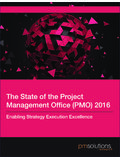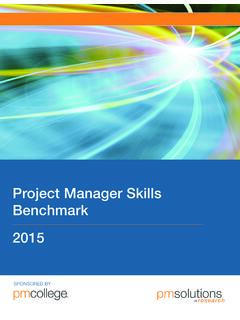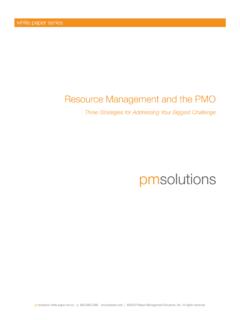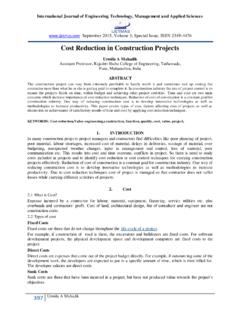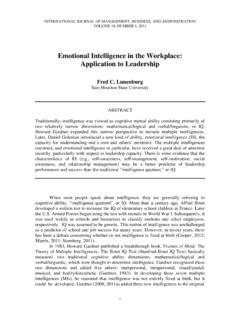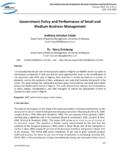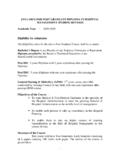Transcription of Project Management Roles & Responsibilities
1 The Center for Business Practices is the research and publishing arm of PM Solutions. For more information, visit Kent CrawfordJeannette Cabanis-Brewin Deborah Bigelow CrawfordJames S. PennypackerProject Management Roles & ResponsibilitiesSECOND EDITIONthe center for business practices Project ManagementRoles & ResponsibilitiesProject ManagementRoles & ResponsibilitiesSECOND EDITIONJ. Kent CrawfordJeannette Cabanis-BrewinDeborah Bigelow CrawfordJames S. PennypackerCenter for Business Practices4 Project Management Roles & RESPONSIBILITIESISBN: 978-1-929576-26-5 HeadquartersCenter for Business Practices1788 Wilmington PikeGlen Mills, Pennsylvania 19342 USAtel: Wide publisher offers discounts on this book when ordered in bulk quantities.
2 For more information, write to Special Sales/Professional Marketing at the headquarters address is a trademark and PMP is a certifi cation mark of the Project Man-agement Institute, Inc. which are registered in the United States of America and other 2008 by Center for Business Practices. All Rights this book nor any part may be reproduced or transmitted in any form or by any means, electronic or mechanical, including photocopying, microfi lming, and recording, or by any information storage and retrieval system, without permission in writing from the printing (last digit):10 9 8 7 6 5 4 3 2 1 PRINTED IN THE UNITED STATES OF AMERICA5 ContentsProject People: The Solution that Works 7J. Kent Crawford and Jeannette Cabanis-BrewinProject Offi ce Roles & Responsibilities 11J.
3 Kent Crawford and Jeannette Cabanis-Brewin ROLESC hief Project Offi cer 14 Project Portfolio Manager 17 Strategic Project Offi ce Director 20 Manager of Project Support 23 Manager of Project Managers 25 Project Management Mentor 28 Program Manager 30 Project Manager 33 Project Team Leader 38 Project Support Team Member 39 Project Controller 40 Project Planner 43 Project Scheduler 46 Project Estimator 48 Risk Management Coordinator 50 Methodologist 52 Measurement Analyst 54 Business Analyst 56 Project Offi ce Administrator 57 Organization Development Specialist 59 Systems Analyst 61 Knowledge Management Coordinator 63 Communications Planner 65 Relationship Manager 676 Project Management Roles & RESPONSIBILITIESDoes Your Organization Have a CPO?
4 69 Deborah Bigelow CrawfordThe Strategic Project Offi ce: Executive Roles and Responsibilities 73J. Kent Crawford and Jeannette Cabanis-Brewin The Right Stuff: Competency-Based Employment 79J. Kent Crawford and Jeannette Cabanis-BrewinNew Staffi ng Models Boost Project Effi ciency 89J. Kent Crawford and Jeannette Cabanis-BrewinProject Control Functions: Benchmarks of Current Business Practices 107 James S. PennypackerAbout the Authors 111 About the Center for Business Practices 1127 Project PeopleThe Solution That Worksby J. Kent Crawford and Jeannette Cabanis-BrewinLet s be frank: Better Project Management is carried out by better Project personnel. Period. Most of the reasons technology projects fail are Management -related rather than technical, yet many enter-prises have no processes in place to ensure that Project managers are appropriately trained and evaluated.
5 Competent and experienced Project managers are not accidental: they are grown in an environ-ment that trains, mentors, and rewards them based on performance on projects. Thus, best practices for preventing Project failure often include changes in the Management of Project ts of having a good Project manager include reduced proj-ect expense, higher morale, and quicker time to market. The skills most executives cite as desirable in a Project manager are: technology and business knowledge, negotiation, good communications (includ-ing writing ability), organization; diplomacy and time Management . Understanding the business is more important than understand-ing technology. They must be able to defi ne requirements, estimate resources and schedule their delivery, budget and manage costs, motivate teams, resolve confl icts, negotiate external resources, man-age contracts, assess and reduce risks, and adhere to a standard methodology and quality processes.
6 Obviously, there is a growing body of knowledge about who makes the best Project manager, how to develop their skills, and what kinds of rewards motivate them. After years of development, that body of knowledge fi nally has an organizational home in the enterprise-level Project Offi ce. And, of course, good Project managers aren t born that way. They grow into the role by working in other Roles on Project teams. A 8 Project Management Roles & RESPONSIBILITIESP roject Offi ce is good news for Project managers and team members, as it focuses attention on the training, rewards, and career path of the Project professional. But it s also good news for the bottom line, since it translates the improved capabilities of individuals into better Project Management .
7 Better portfolio Management .. and strategies that are executed. At the same time, it resolves many of the issues of motivation and retention that bedevil human resources managers. For a decade or more, writers in the HR and organizational development fi elds have been telling us that today s workers are changing: becoming more achievement oriented, less motivated by the hygiene factors of mon-ey, benefi ts and safety, and more driven by the need for what Abra-ham Maslow called self-actualizing work. Project work, because of its time-limited and cross-disciplinary nature, offers people zest a sense of urgency, continuous learning, contacts with a wide variety of colleagues within and without their specialty areas, and repeated new challenges.
8 On the organizational level, it makes possible the fl atten-ing and streamlining of Management , reducing bureaucracy, facilitat-ing the development of intellectual capital, and helping the organiza-tion to stay focused on strategic Project - and People-Centered OrganizationIf your company has a system in place for educating, mentoring, and evaluating Project personnel, you are in the minority. Many compa-nies do not even know how many people they have who are capable of managing projects. This has led to the unfortunate phenomenon of the accidental Project manager. We would not think of dumping major accounting Responsibilities on whoever happened to be avail-able, even though they had no background in accounting. Yet this is routinely done even with major projects, even though the skill set and knowledge you need to effectively deploy a Project Management initiative rivals the knowledge set of an MBA in terms of complexity and the Project -centered enterprise, in which people are treated as though Project performance really mattered to organizational per-formance, isn t a theory.
9 In fact, it s the logical outcome of the appli-cation of Project Management to business problems. In the industries 9where the practice of Project Management has long been accepted as the way to get work done, such enterprises already exist. A study of organizations with strong Project Management capability, and the related ability to leverage projects for competitive success, found that these companies display two people-centered best practices: 1. Project -centered Role Design. Project managers are given the resources and authority to match their Project responsibility and held accountable by their superiors for the extent to which they achieve targets. But, at the same time, a Project director role is created and positioned as the immediate superior of a number of Project managers.
10 Meanwhile, career paths lead individuals through Project teamwork into Project leadership. Organizational Roles are specifi cally defi ned around Project Valuing Project Managers. Successful Project -centered compa-nies treat their Project managers as an asset, retaining them in bad economic times, and being tolerant of mistakes. A sense that the company values and trusts the Project manager results in more ac-curate estimating and reporting, and in the preservation of organi-zational all this focus on Roles and Responsibilities ? From within the ranks of high-performance Project managers will come the next generation of Project executives: Project Offi ce Directors, Portfolio Managers, CIOs .. perhaps even CEOs. Experienced Project manag-ers with the aptitude for business bring a valuable Project -focused intelligence to corporate leadership.


